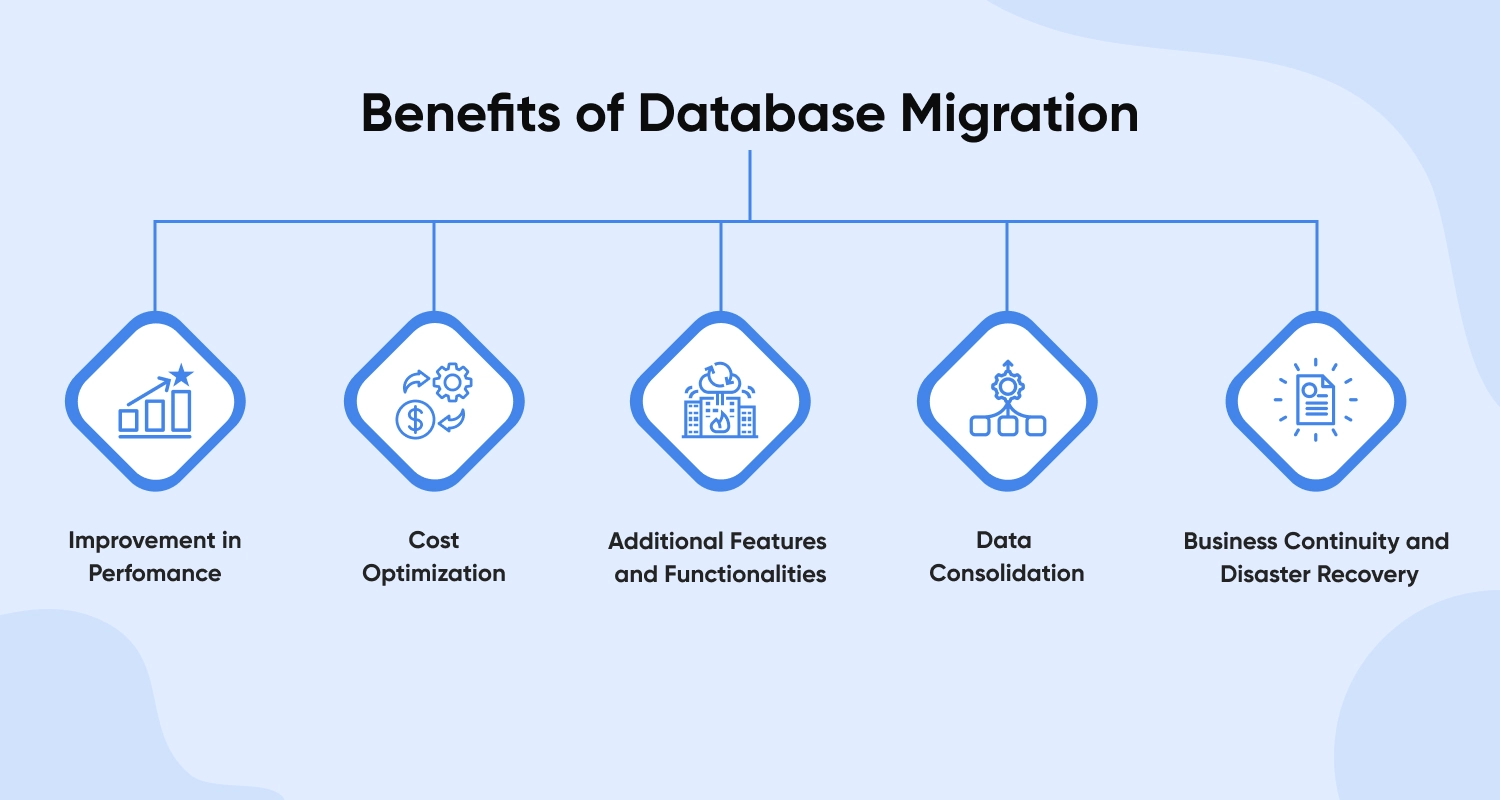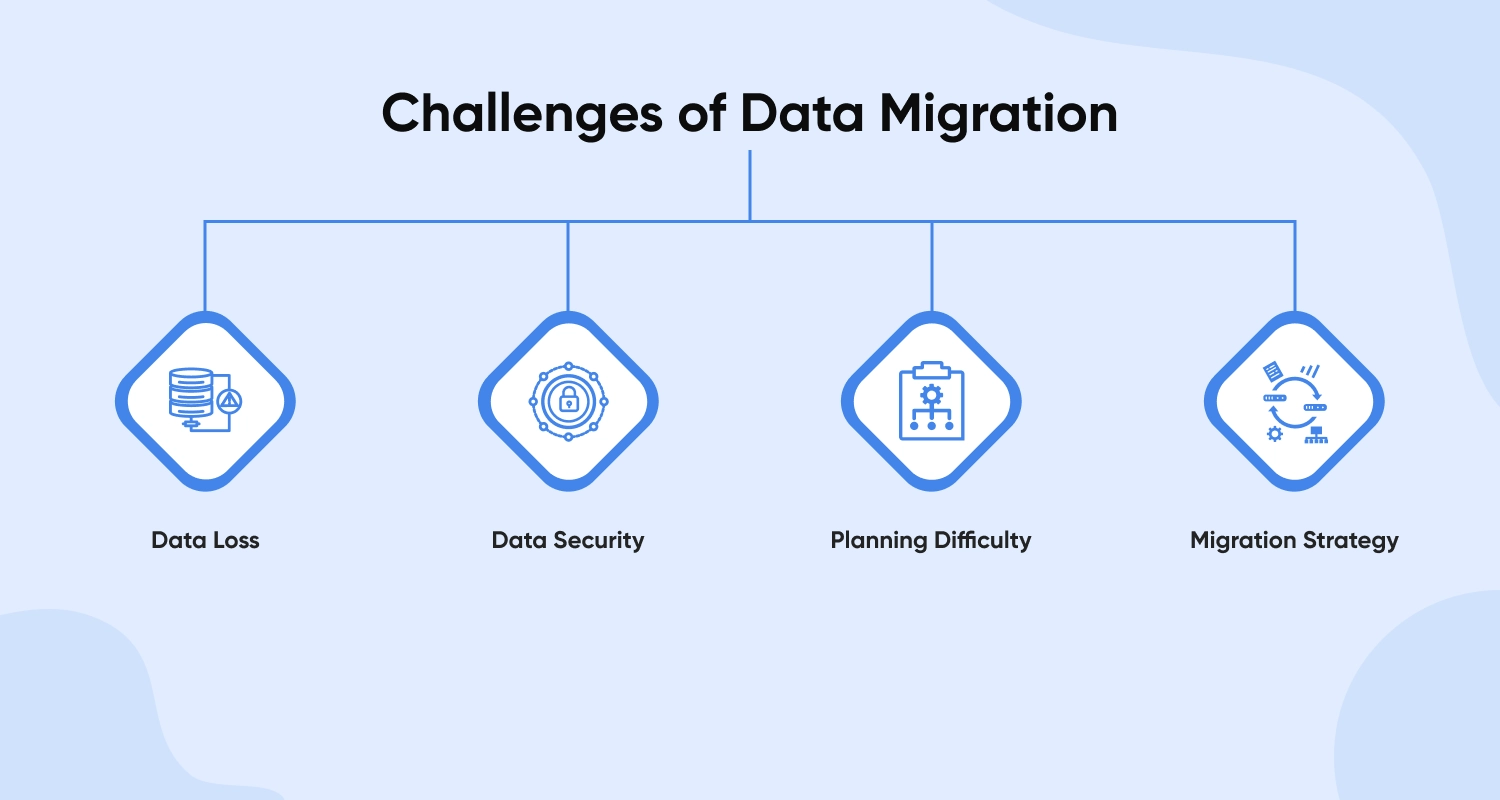With the increasing popularity of GIT and version control, the trend of writing web-based applications using ORM libraries is gaining traction. But, why is it so? Well, GIT allows developers to control their code versions and easily roll back changes when necessary. The added convenience got everyone thinking of implementing the same with schema changes. This is why popular web frameworks like Rails and Django added ORM and database migration features. An important point to note is that database migration is not limited to these frameworks.
As businesses need to scale over time, their data ecosystem must change accordingly. This not only allows better handling of applications, but also helps enterprises save costs, enhance scalability, and achieve reliability. Moreover, business applications change with time including the addition of new features or changes in existing functionalities. This is why businesses must invest in database migration along with custom software development.
To help you better understand the need for database migration along with its benefits, challenges, and points to help tackle them, we have created the detailed article below. So, what are you waiting for? Jump right into it to get started with learning more about database migration and investing in it as soon as possible.
What Is A Database Migration?
Although database migration is a complicated process that we will get into in detail in the following sections, it would be better to explain the core idea in simple terms.
The simple answer to “what is a database migration” is – it is the process of data transportation from one or more databases/platforms to another target database/platform. It is a multi-phase process that involves different actions like moving data, assessing schemas, understanding the different objects like tables and objects, testing functions and methods, performance tuning, and multiple other steps.
It is clear that database migration is quite complicated and requires a lot of effort. So, the obvious question is – what is the need for database migrations? To help you understand the need for this difficult process, we have answered this question in the following section.
What Is The Need For Database Migration?
As technology continues to advance and businesses need to handle more and more data, it is important that organizations adapt to new technologies. This is essential as new technologies are better capable of handling large numbers of users while helping boost the application’s performance and efficiency. Some reasons for database migration to help understand why it is the need of the hour are:-
1. Save Business Costs
Since old technologies operate slower than advanced upgrades, using old databases might take a lot of time. This means that simple business processes will take up a lot of time and your infrastructure resources will be kept in use for longer. So, other business processes will be on hold until the resources free up. When your developers perform database migration, they ensure that your business saves on infrastructure and manpower required to support the database. Ultimately, this helps reduce business costs while offering greater flexibility and scope for improvement.
2. Upgrade Infrastructure
One of the most common reasons for businesses looking for data migration is their need to shift to a new system. After all, outdated systems are not only difficult to maintain, but might also not fulfill the current business demands. Moreover, with the introduction of new technologies like big data, business systems must be capable of handling huge amounts of data and processing them for better results.
3. Reduce Redundancy
Often, companies realize that their data is not stored in a comprehensive manner which can cause problems in business functioning. This also means that different business teams do not have access to accurate data and cannot deliver transparent services. In these cases, database migration is essential and necessary to move the complete business data in a single place. Doing so also promotes collaboration and ensures that all business departments and teams are in sync.
4. Security Patches And Updates
Databases are one of the most vulnerable points of cyberattacks since most businesses forget to upgrade them with time. So, they are quite easy to get through and fail more than other systems. With database migration, businesses get access to professional database migration service that includes database upgrades with better security options. So, the only way to update your database and ensure that it is not a point for data leaks is via database migration and degradation.

What Happens During Database Migration?
Now that we know how database migrations came into existence and why they are needed, let us move on to discussing what the process actually entails.
Generation Of Granular Changes As Individual Scripted Files
Basically, database migrations track granular changes to the schema of the database and in some cases, changes made to the data too. Typically, these changes are listed and stored as separate schema files to enable the proper reflection of code changes via version control software. Another point to note is that these files are not only available as individual scripts, but you can also find the current schema of the database as its own file (also known as the schema file).
Tool-Dependent Database Migration Scripts
Popular web frameworks and migration tools can produce migration changes in multiple file formats like JSON and XML. This means that there is no standard that is followed when it comes to database migration and the creation of relevant files. But, you can also custom-write your database migration script in the form of SQL. However, a downside is that handwriting codes means that the process becomes time-consuming and there is a high potential of errors creeping into the code.
What Are The Benefits Of Database Migration?

Some common benefits of database migration that have helped boost its popularity include:-
1. Improvement In Performance
Since database migration means the inclusion of new and advanced technologies, the target databases generally offer improved performance due to the optimization of resources, hardware, and infrastructure. Moreover, database migration includes the optimization of database design and indexing strategies, segmentation and partition of data, and the proper utilization of advanced database features.
2. Cost Optimization
By migrating to cloud-based technologies, businesses can avoid major investments in resources, hardware, and infrastructure. Instead, they can leverage tools available on a pay-as-you-use basis. Moreover, cloud-based solutions offer effective storage and help ensure proper data maintenance for better business efficiency.
3. Additional Features And Functionalities
Since database migrations use advanced technologies, they allow businesses to better leverage additional features and functionalities. For example, new systems support new data types, implement data analytics, and have built-in support that ensures high availability.
4. Data Consolidation
Often, multiple databases exist within an organization’s infrastructure which can lead to improper data management and coordination. Migrating these into a single database via database migration can help simplify the complete data management process, reduce instances of duplicate data, enable better data integrity, and allow instant formation of in-depth reports.
5. Business Continuity And Disaster Recovery
With database migration, businesses can migrate their organizational data into secure systems and platforms. This helps minimize the risk of data loss and allows better recovery of data in case of issues. Moreover, cloud-based solutions offer better data availability that is not dependent on hardware and helps prevent system disruption due to hardware and system failures.
You may like this: Realm Local Databases in React Native App Development
What Are The Challenges In Database Migration?

Although database migration is gaining popularity now, it has been a common practice for years. The process is quite complicated which gives rise to some common challenges listed below. Following DB migration best practices can help avoid these issues as much as possible.
1. Data Loss
The most common issue that organizations face during database migration is the loss of data. To avoid this, it is crucial to test for data loss or data corruption in the planning stage to ensure that the complete data is migrated to the target database. Doing this early on will help ensure that you can solve these challenges when you are not deep in database migration.
2. Data Security
Since data is of utmost importance to a business’s performance and proper functioning, data security is crucial. Before you go through data migration, focus on data encryption to ensure that your data is not put at risk during the process.
3. Planning Difficulty
Most multinational companies have their data spread across multiple databases which also spread across different geographical areas. Before db migration, companies must locate these databases and plan how to convert their schemas to ensure proper data migration into the target database. Beware that the planning process before database migration can become quite complicated and time-consuming.
4. Migration Strategy
The most obvious question, when companies learn about database migration, is – how is the DB migration done? Due to this lack of knowledge, companies often miss out on several crucial steps and adopt a strategy that is not suitable for their company. This can cause problems like data storage and maintenance in the future and might lead to system failures.
How To Perform Database Migration (Steps)?
To help you better plan your database migration strategy, we have broken down the multi-step process into a few simple steps. Check out the steps listed below and get ready to migrate your data:-
1. Proper Understanding Of The Source Database
An important step in the database migration process is understanding the source data that needs to be migrated to the target database. Some common questions that you must be able to understand before you go through the DB migration process include:-
- What is the size of the data stored in the source database? – The scope of your db migration project is highly dependent on the size and complexity of the source data that is to be migrated. This will also help you understand the amount of computing resources and time required to migrate your data into the target database.
- Does the data set contain huge tables? – When your data consists of tables with millions of rows, the migration process becomes quite complicated. In these cases, it would be wise to use database migration tools.
- What are the different data types involved in the database migration process? – When you migrate your data between different databases, you will need to consider the schema of the databases and decide on the schema of your target database for successful data migration.
2. Data Assessment
This step refers to the granular assessment of data before businesses go through database migration. You must profile the source data present in the database and set data quality rules that help remove data inconsistencies, duplicate records, and incorrect information. Properly assessing your data and completing your data profile will help mitigate the risk of delays and help you avoid budget overruns.
3. Conversion Of Database Schema
Often, businesses need to perform heterogeneous data migrations, meaning migrating data between different database engines. This process is wildly different from single database migrations and can be quite complicated. Although you can manually convert schemas for DB migrations, it is quite time-consuming and can take up a lot of resources. This is why we recommend using data migration tools and services to aid the migration process and help you quickly perform it.
4. Migration Build Tests
Adopting an iterative process can help better implement and test a migration build. It is advisable to start with a small data subset, profile it, and convert the schema into a fully running migration exercise. Doing so will help ensure data mapping, transformations, and data quality rules work as you intended.
5. Execution Of The Migration
Since database migration takes time, companies must plan the execution of their migration projects during the downtime. It is important to better plan your database moving projects to ensure that your system does not run into issues, failures, and interruptions. After all, this can disrupt client services and affect the complete business process.
You may like this: Firebase vs MongoDB: Battle of The Best Databases
Are There Any Database Migration Tools?
The top db migration tools that you can utilize for quicker data migration are:-
1. AWS Database Migration Services
AWS database migration services are one of the most popular migration suites offered by Amazon. The cloud data migration tool offers businesses hybrid data storage and online and offline data transfers. Moreover, they include a wide range of services that help users move datasets irrespective of the data type and schema.
2. Informix
Another excellent database migration tool, Informix has been developed by IBM and allows migration of data from one IBM database to another. This tool primarily focuses on homogenous data migrations and is suitable for relational systems. Moreover, the tool is a high-speed and flexible database that easily integrates with SQL, NoSQL, or JSON, and spatial data.
3. Azure Database Migration Services
Owned by Microsoft, Azure’s database migration tool allows users to simplify and automate the complete data migration process. With the help of this tool, users can easily migrate databases from SQL servers, MySQL database, PostgreSQL database, MongoDB, and Oracle to the Azure cloud.
Expedite Your Business’ Database Migration With CMARIX
Since database migration is quite complicated, it can be time-consuming and expensive. However, it is important to complete the DB migration process on time to ensure that the company’s revenue and reputation do not take a hit. With functional testing tools and enterprise-grade database migration tools, you can easily automate repetitive tasks and ensure better maintenance of data quality.
At CMARIX, we design end-to-end database migration solutions that cater to the complex needs of every business. Moreover, our team of experts has years of professional experience in the fields of data migration and maintenance. Interested in learning more and utilizing expert database migration services? Get in touch with us to discuss your goals or for a quick demo!
Frequently Asked Questions
The potential challenges of the database migration process include – data loss, data security, planning complexity, and migration strategy. To learn about these in detail, please refer to the detailed article above.
To better handle data transformation and mapping between source and target databases, users must analyze the schemas to develop an in-depth strategy. You can read our detailed article to know more about the DB migration best practices to avoid data loss.
Although database migration is complicated, it is necessary to ensure data integrity and consistency between source and target data. So, your testing environment must mimic the production setup to ensure that you do not face any future system challenges.
During the migration, some common fields to check to ensure better integrity and data consistency are – missing fields, data attributes, and data accuracy.
To preserve the key functionalities during data migration, all you need to do is ensure that the source data is consistent with the target data. You can hire experienced developers to ensure that the key functionalities are preserved and your business runs smoothly.
